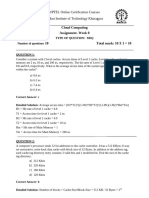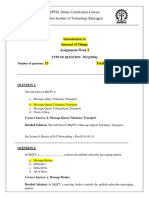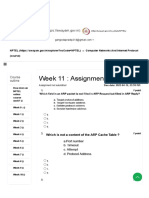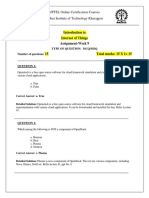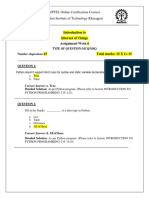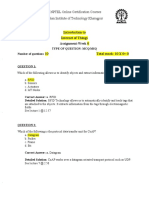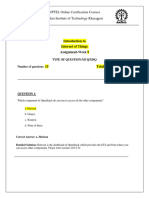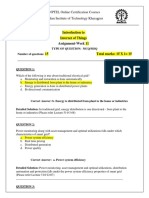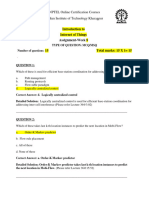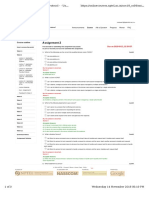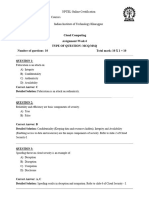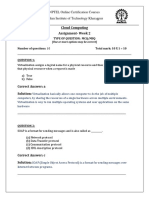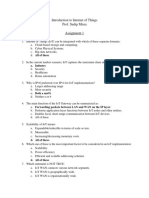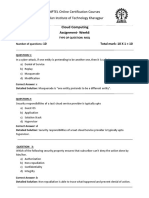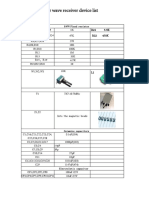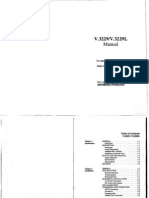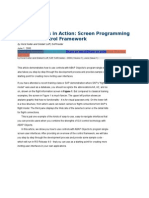NPTEL Online Certification Courses
Indian Institute of Technology Kharagpur
Computer Network and Internet Protocol
(Jan 2024)
Assignment- Week 0
TYPE OF QUESTION: MCQ/MSQ
Number of questions: 10 Total mark: 10 X 1 = 10
QUESTION 1:
Which of this is not a network edge device?
a) Switch
b) PC
c) Smartphones
d) Servers
Correct Answer: (a)
Explanation: Network edge devices refer to host systems, which can host applications like web
browser. A switch can’t operate as a host, but as a central device which can be used to manage
network communication.
QUESTION 2:
What is the full form of OSI?
a) optical service implementation
b) open service internet
c) open system interconnection
d) operating system interface
Correct Answer: (c)
Explanation: OSI is the abbreviation for Open System Interconnection. OSI model provides a
structured plan on how applications communicate over a network, which also helps us to have a
structured plan for troubleshooting. It is recognized by the ISO as the generalized model for
computer network i.e., it can be modified to design any kind of computer network.
QUESTION 3:
How many layers are there in the ISO OSI reference model?
a) 7
b) 5
c) 4
d) 6
Correct Answer: (a)
1
� NPTEL Online Certification Courses
Indian Institute of Technology Kharagpur
Explanation: The seven layers in ISO OSI reference model is Application, Presentation, Session,
Transport, Network, Data link and Physical layer. OSI stands for Open System Interconnect and it
is a generalized model.
QUESTION 4:
What is the full form of HTTP?
a) Hypertext transfer policy
b) Hypertext transfer protocol
c) Hypertext transmission policy
d) Hypertext transmission protocol
Correct Answer: (b)
Explanation: The full form of HTTP is hypertext transfer protocol
QUESTION 5:
Which type of network shares the communication channel among all the machines??
a) anycast network
b) multicast network
c) unicast network
d) broadcast network
Correct Answer: (d)
Explanation: In a broadcast network, information is sent to all stations in a network whereas in a
multicast network the data or information is sent to a group of stations in the network. In unicast
network, information is sent to only one specific station. The broadcast address of the network is
the last assigned address of the network.
QUESTION 6:
Identify the first network which was based on TCP/IP protocol
a) WWW
b) LAN
c) WAN
d) APRANET
Correct Answer: (d)
Explanation: APRANET is the first based on TCP/IP protocol.
2
� NPTEL Online Certification Courses
Indian Institute of Technology Kharagpur
QUESTION 7:
What is the maximum number of hosts possible under class B addresses?
a) 65536
b) 65534
c) 65532
d) 254
Correct Answer: (b)
Explanation: In Class B IP address first two octets are used to represent the network number,
which leaves two octets or 16 bits to represent the host portion of the address. With 16 bits total,
216 combinations are possible, yielding 65,536 Class B addresses. However, two of those numbers,
the lowest and highest values, are reserved for special purposes. Therefore, the pool of Class B
address can support up to 65,534 hosts.
QUESTION 8:
Suppose computers P and Q have IP addresses 10.20.5.25 and 10.20.5.9 respectively and they both
use the same netmask N. Which of the values of N given below should not be used if P and Q
should belong to the same network?
a) 255.255.255.240
b) 255.255.255.128
c) 255.255.255.192
d) 255.255.255.224
Correct Answer: (a)
Explanation: For N = 255.255.255.10000000, both P and Q’s network IP is 10.20.5.0
For N = 255.255.255.11000000, both P and Q’s network IP is 10.20.5.0
For N = 255.255.255.11100000, both P and Q’s network IP is 10.20.5.0
For N = 255.255.255.11110000, P’s network IP is 10.20.5.16, and that of Q 10.20.5.0 which is
different. So the correct answer is 255.255.255.240.
QUESTION 9:
What is supernetting?
a) splitting a large network into multiple small networks
b) combining multiple small networks in a single large network
c) enabling the network to accept more hosts
d) connecting a new network to an existing network
Correct Answer: (b)
Explanation: Supernetting is a computer networking technique that combines multiple smaller
network addresses into a single larger network address. It's also known as route summarization or
aggregation.
3
� NPTEL Online Certification Courses
Indian Institute of Technology Kharagpur
QUESTION 10:
“The network layer guarantees the delivery of each packet in the same order of which it is sent.”
The above statement is:
a) true
b) false
Correct Answer: (b)
Explanation: The network layer doesn’t guarantee delivery of each packet and doesn’t promise to
deliver them in the same order


